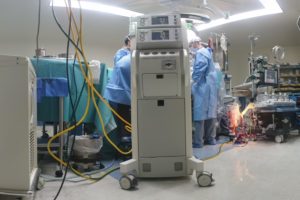The Abbott Northwestern Hospital in Minneapolis is seeing success treating emergency room patients with acupuncture. The hospital became the first in America to add acupuncture into its ER program two years ago. This was a way to reduce the amount of opioids administered to patients. Since hired, acupuncturist Adam Reinstein has treated patients from car accident injuries and kidney stone pain. “No matter what I’m treating them for, patients report feeling calmer, and less anxious” said Reinstein. The Research Titled “Acceptability, Adaptation, and Clinical Outcomes of Acupuncture Provided in the Emergency Department,” their paper was published in the Pain Medicine
Read more →Pain
Acupuncture use in the US Military is on the rise. The epidemic of prescription drug use in the United States has led the US military to take a serious look at the effectiveness of its pain and PTSD protocols. Acupuncture Use Increases In military bases across America and overseas, acupuncture is being put to use. Used primarily for PTSD and the treatment of pain, acupuncture is increasing for active duty members. In particular, auricular acupuncture is gaining a lot of traction for its ability to be performed quickly and in unstable circumstances. Battlefield Acupuncture Retired Air Force Colonel Richard Niemtzow,
Read more →One of the most over used joints in our body is the temporo-mandibular joint (TMJ joint for short). The TMJ joint and the ligaments and muscles that surround it connect the lower jaw to the skull. These muscles and ligaments stretch and strain as they provide movement to talk, chew and clench. When the TMJ joint becomes overworked and tight it can lead to what’s called a TMJ dysfunction. What Causes TMJ Dysfunction? Emotional & physical stress Grinding or clenching teeth Injuries or fractures of the joint Missing teeth, poorly shaped teeth Crowns or bridges Degenerative diseases such as arthritis Common
Read more →There are many reasons why people experience pain, however one common complaint people have is carpal tunnel syndrome. What is Carpal Tunnel Syndrome? When there is compression of the median nerve on the palm side of the wrist between tendons that flex the hand. This is called carpal tunnel syndrome. How Does it Develop? There are a number of reasons why carpal tunnel syndrome can develop. Firstly trauma of the wrist may lead to thickness of the flexor retinaculum, creating compression of the median nerve. Secondly oedema or thickness of the soft tissue, lipoma or ganglion in the carpal tunnel
Read more →Most people describe pain on the inner side of the elbow as “golfers elbow” while doctors use the term medial epicondylitis. On a wider scale, a small percentage of people diagnosed with golfers elbow actually play golf! What is Golfer’s Elbow? When there is strain of the inner part of the elbow (medical epicondyle), it causes inflammation and acute or chronic pain. How Does it Develop? Overusing the forearm can create fatigue in the muscles and tendons. This fatigue increases the chance of muscle and tendon strain and tears, leading to inflammation. In Chinese medicine, there’s an additional reason why
Read more →Most people describe pain on the outside of the elbow as “tennis elbow”, while doctors call it lateral epicondylitis. On a wider scale less than 5% of people diagnosed with tennis elbow actually play tennis. How Does it Develop? Tennis elbow manifests when there’s strain of the forearm (extensor muscles) and their attachments near the outside of the elbow. Overusing and repetitive moving forearm muscles can create strain and tears in the muscle and tendons, leading to inflammation. In Chinese medicine, there is an additional reason why some people are prone to these types of inflammatory conditions. Once reason is
Read more →Acupuncture and Chinese medicine have had a long history treating tension headaches. Today, tension headaches are one of the most prevalent medical complaints in Australia. What Is a Tension Headache? Firstly, tension headache is characterized by frequent or continuous mild pain on both sides of the head, with a vise-like grip in the back of head or forehead. This can spread over the entire head and get worse toward the end of the day. It’s common for people to experience tension headache less than 15 days per month. When symptoms appear more than 15 days per month, they’re considered chronic.
Read more →





